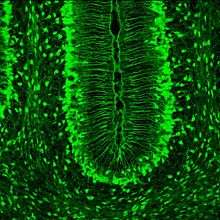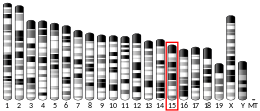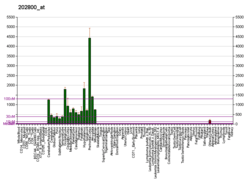Excitatory amino acid transporter 1
Excitatory amino acid transporter 1 (EAAT1) is a protein that, in humans, is encoded by the SLC1A3 gene.[5] EAAT1 is also often called the GLutamate ASpartate Transporter 1 (GLAST-1).
EAAT1 is predominantly expressed in the plasma membrane, allowing it to remove glutamate from the extracellular space.[6] It has also been localized in the inner mitochondrial membrane as part of the malate-aspartate shuttle.[7]
Mechanism
EAAT1 functions in vivo as a homotrimer.[8] EAAT1 mediates the transport of glutamic and aspartic acid with the cotransport of three Na+ and one H+ cations and counter transport of one K+ cation. This co-transport coupling (or symport) allows the transport of glutamate into cells against a concentration gradient.[9]
 "Diagram Illustrating the Malate-Aspartate Shuttle Pathway". (Glutamate aspartate transporter labeled at bottom center.)
"Diagram Illustrating the Malate-Aspartate Shuttle Pathway". (Glutamate aspartate transporter labeled at bottom center.) Expression of SLC1A3 in the Bergmann glia fibers. Mouse brain at 7th postnatal day, sagittal section; GENSAT database.
Expression of SLC1A3 in the Bergmann glia fibers. Mouse brain at 7th postnatal day, sagittal section; GENSAT database.
Tissue distribution
EAAT1 is expressed throughout the CNS,[10] and is highly expressed in astrocytes and Bergmann glia in the cerebellum.[11][12] In the retina, EAAT1 is expressed in Muller cells.[13] EAAT1 is also expressed in a number of other tissues including cardiac myocytes.[7]
Clinical significance
It is associated with type 6 episodic ataxia.[14] EAAT1 expression may also be associated with osteoarthritis.[15]
Pharmacology
DL-threo-beta-benzyloxyaspartate (TBOA) is an inhibitor of the excitatory amino acid transporters.[16]
Selective inhibitors for EAAT1 have recently been discovered based on 25 combinations of substitutions at the 4 and 7 positions of 2-amino-5-oxo-5,6,7,8-tetrahydro-4H-chromene-3-carbonitril.[17]
References
- GRCh38: Ensembl release 89: ENSG00000079215 - Ensembl, May 2017
- GRCm38: Ensembl release 89: ENSMUSG00000005360 - Ensembl, May 2017
- "Human PubMed Reference:". National Center for Biotechnology Information, U.S. National Library of Medicine.
- "Mouse PubMed Reference:". National Center for Biotechnology Information, U.S. National Library of Medicine.
- "Entrez Gene: SLC1A3 solute carrier family 1 (glial high affinity glutamate transporter), member 3".
- Lehre KP, Levy LM, Ottersen OP, Storm-Mathisen J, Danbolt NC (March 1995). "Differential expression of two glial glutamate transporters in the rat brain: quantitative and immunocytochemical observations". The Journal of Neuroscience. 15 (3 Pt 1): 1835–53. doi:10.1523/JNEUROSCI.15-03-01835.1995. PMC 6578153. PMID 7891138.
- Ralphe JC, Segar JL, Schutte BC, Scholz TD (July 2004). "Localization and function of the brain excitatory amino acid transporter type 1 in cardiac mitochondria". Journal of Molecular and Cellular Cardiology. 37 (1): 33–41. doi:10.1016/j.yjmcc.2004.04.008. PMID 15242733.
- Gendreau S, Voswinkel S, Torres-Salazar D, Lang N, Heidtmann H, Detro-Dassen S, Schmalzing G, Hidalgo P, Fahlke C (September 2004). "A trimeric quaternary structure is conserved in bacterial and human glutamate transporters". The Journal of Biological Chemistry. 279 (38): 39505–12. doi:10.1074/jbc.M408038200. PMID 15265858.
- Kanai Y, Hediger MA (February 2004). "The glutamate/neutral amino acid transporter family SLC1: molecular, physiological and pharmacological aspects". Pflügers Archiv. 447 (5): 469–79. doi:10.1007/s00424-003-1146-4. PMID 14530974.
- Danbolt NC (September 2001). "Glutamate uptake". Progress in Neurobiology. 65 (1): 1–105. doi:10.1016/S0301-0082(00)00067-8. PMID 11369436.
- Storck T, Schulte S, Hofmann K, Stoffel W (November 1992). "Structure, expression, and functional analysis of a Na(+)-dependent glutamate/aspartate transporter from rat brain". Proceedings of the National Academy of Sciences of the United States of America. 89 (22): 10955–9. Bibcode:1992PNAS...8910955S. doi:10.1073/pnas.89.22.10955. PMC 50461. PMID 1279699.
- Rothstein JD, Martin L, Levey AI, Dykes-Hoberg M, Jin L, Wu D, Nash N, Kuncl RW (September 1994). "Localization of neuronal and glial glutamate transporters". Neuron. 13 (3): 713–25. doi:10.1016/0896-6273(94)90038-8. PMID 7917301.
- Rauen T, Taylor WR, Kuhlbrodt K, Wiessner M (January 1998). "High-affinity glutamate transporters in the rat retina: a major role of the glial glutamate transporter GLAST-1 in transmitter clearance". Cell and Tissue Research. 291 (1): 19–31. doi:10.1007/s004410050976. PMID 9394040.
- Jen JC, Wan J, Palos TP, Howard BD, Baloh RW (August 2005). "Mutation in the glutamate transporter EAAT1 causes episodic ataxia, hemiplegia, and seizures". Neurology. 65 (4): 529–34. doi:10.1212/01.WNL.0000172638.58172.5a. PMID 16116111.
- Mason DJ, Brakspear K, Wilson C, Williams R, Kotwal RS (July 2010). "Expression of glutamate receptors and transporters in human subchondral bone in osteoarthritis". Orthopaedic Proceedings. The British Editorial Society of Bone & Joint Surgery. 93-B (SUPP_I): 411. doi:10.1302/0301-620X.93BSUPP_I.0930069b (inactive 2020-05-21).
- Shimamoto K, Lebrun B, Yasuda-Kamatani Y, Sakaitani M, Shigeri Y, Yumoto N, Nakajima T (February 1998). "DL-threo-beta-benzyloxyaspartate, a potent blocker of excitatory amino acid transporters". Molecular Pharmacology. 53 (2): 195–201. doi:10.1124/mol.53.2.195. PMID 9463476.
- Jensen AA, Erichsen MN, Nielsen CW, Stensbøl TB, Kehler J, Bunch L (February 2009). "Discovery of the first selective inhibitor of excitatory amino acid transporter subtype 1". Journal of Medicinal Chemistry. 52 (4): 912–5. doi:10.1021/jm8013458. PMID 19161278.
Further reading
- Arriza JL, Fairman WA, Wadiche JI, Murdoch GH, Kavanaugh MP, Amara SG (September 1994). "Functional comparisons of three glutamate transporter subtypes cloned from human motor cortex". The Journal of Neuroscience. 14 (9): 5559–69. doi:10.1523/jneurosci.14-09-05559.1994. PMC 6577102. PMID 7521911.
- Nomura N, Nagase T, Miyajima N, Sazuka T, Tanaka A, Sato S, Seki N, Kawarabayasi Y, Ishikawa K, Tabata S (1995). "Prediction of the coding sequences of unidentified human genes. II. The coding sequences of 40 new genes (KIAA0041-KIAA0080) deduced by analysis of cDNA clones from human cell line KG-1". DNA Research. 1 (5): 223–9. doi:10.1093/dnares/1.5.223. PMID 7584044.
- Takai S, Yamada K, Kawakami H, Tanaka K, Nakamura S (1995). "Localization of the gene (SLC1A3) encoding human glutamate transporter (GluT-1) to 5p13 by fluorescence in situ hybridization". Cytogenetics and Cell Genetics. 69 (3–4): 209–10. doi:10.1159/000133965. PMID 7698014.
- Shashidharan P, Huntley GW, Meyer T, Morrison JH, Plaitakis A (October 1994). "Neuron-specific human glutamate transporter: molecular cloning, characterization and expression in human brain". Brain Research. 662 (1–2): 245–50. doi:10.1016/0006-8993(94)90819-2. PMID 7859077.
- Kirschner MA, Arriza JL, Copeland NG, Gilbert DJ, Jenkins NA, Magenis E, Amara SG (August 1994). "The mouse and human excitatory amino acid transporter gene (EAAT1) maps to mouse chromosome 15 and a region of syntenic homology on human chromosome 5". Genomics. 22 (3): 631–3. doi:10.1006/geno.1994.1437. PMID 8001975.
- Kawakami H, Tanaka K, Nakayama T, Inoue K, Nakamura S (February 1994). "Cloning and expression of a human glutamate transporter". Biochemical and Biophysical Research Communications. 199 (1): 171–6. doi:10.1006/bbrc.1994.1210. PMID 8123008.
- Shashidharan P, Plaitakis A (October 1993). "Cloning and characterization of a glutamate transporter cDNA from human cerebellum". Biochimica et Biophysica Acta (BBA) - Gene Structure and Expression. 1216 (1): 161–4. doi:10.1016/0167-4781(93)90057-K. PMID 8218410.
- Andersson B, Wentland MA, Ricafrente JY, Liu W, Gibbs RA (April 1996). "A "double adaptor" method for improved shotgun library construction". Analytical Biochemistry. 236 (1): 107–13. doi:10.1006/abio.1996.0138. PMID 8619474.
- Stoffel W, Sasse J, Düker M, Müller R, Hofmann K, Fink T, Lichter P (May 1996). "Human high affinity, Na(+)-dependent L-glutamate/L-aspartate transporter GLAST-1 (EAAT-1): gene structure and localization to chromosome 5p11-p12". FEBS Letters. 386 (2–3): 189–93. doi:10.1016/0014-5793(96)00424-3. PMID 8647279.
- Yu W, Andersson B, Worley KC, Muzny DM, Ding Y, Liu W, Ricafrente JY, Wentland MA, Lennon G, Gibbs RA (April 1997). "Large-scale concatenation cDNA sequencing". Genome Research. 7 (4): 353–8. doi:10.1101/gr.7.4.353. PMC 139146. PMID 9110174.
- Dunlop J, Lou Z, McIlvain HB (August 1999). "Properties of excitatory amino acid transport in the human U373 astrocytoma cell line". Brain Research. 839 (2): 235–42. doi:10.1016/S0006-8993(99)01714-X. PMID 10519046.
- Koch HP, Kavanaugh MP, Esslinger CS, Zerangue N, Humphrey JM, Amara SG, Chamberlin AR, Bridges RJ (December 1999). "Differentiation of substrate and nonsubstrate inhibitors of the high-affinity, sodium-dependent glutamate transporters". Molecular Pharmacology. 56 (6): 1095–104. doi:10.1124/mol.56.6.1095. PMID 10570036.
- Ye ZC, Rothstein JD, Sontheimer H (December 1999). "Compromised glutamate transport in human glioma cells: reduction-mislocalization of sodium-dependent glutamate transporters and enhanced activity of cystine-glutamate exchange". The Journal of Neuroscience. 19 (24): 10767–77. doi:10.1523/jneurosci.19-24-10767.1999. PMC 6784962. PMID 10594060.
- Szymocha R, Akaoka H, Dutuit M, Malcus C, Didier-Bazes M, Belin MF, Giraudon P (July 2000). "Human T-cell lymphotropic virus type 1-infected T lymphocytes impair catabolism and uptake of glutamate by astrocytes via Tax-1 and tumor necrosis factor alpha". Journal of Virology. 74 (14): 6433–41. doi:10.1128/JVI.74.14.6433-6441.2000. PMC 112151. PMID 10864655.
- Mordrelle A, Jullian E, Costa C, Cormet-Boyaka E, Benamouzig R, Tomé D, Huneau JF (August 2000). "EAAT1 is involved in transport of L-glutamate during differentiation of the Caco-2 cell line". American Journal of Physiology. Gastrointestinal and Liver Physiology. 279 (2): G366-73. doi:10.1152/ajpgi.2000.279.2.G366. PMID 10915646.
- Seal RP, Shigeri Y, Eliasof S, Leighton BH, Amara SG (December 2001). "Sulfhydryl modification of V449C in the glutamate transporter EAAT1 abolishes substrate transport but not the substrate-gated anion conductance". Proceedings of the National Academy of Sciences of the United States of America. 98 (26): 15324–9. Bibcode:2001PNAS...9815324S. doi:10.1073/pnas.011400198. PMC 65028. PMID 11752470.
- Palmada M, Kinne-Saffran E, Centelles JJ, Kinne RK (April 2002). "Benzodiazepines differently modulate EAAT1/GLAST and EAAT2/GLT1 glutamate transporters expressed in CHO cells". Neurochemistry International. 40 (4): 321–6. doi:10.1016/S0197-0186(01)00087-0. PMID 11792462.
- Scott HL, Pow DV, Tannenberg AE, Dodd PR (February 2002). "Aberrant expression of the glutamate transporter excitatory amino acid transporter 1 (EAAT1) in Alzheimer's disease". The Journal of Neuroscience. 22 (3): RC206. doi:10.1523/jneurosci.22-03-j0004.2002. PMC 6758536. PMID 11826152.
- Vallat-Decouvelaere AV, Chrétien F, Gras G, Le Pavec G, Dormont D, Gray F (May 2003). "Expression of excitatory amino acid transporter-1 in brain macrophages and microglia of HIV-infected patients. A neuroprotective role for activated microglia?". Journal of Neuropathology and Experimental Neurology. 62 (5): 475–85. doi:10.1093/jnen/62.5.475. PMID 12769187.
External links
- Glutamate+Aspartate+Transporter+1 at the US National Library of Medicine Medical Subject Headings (MeSH)
- Overview of all the structural information available in the PDB for UniProt: P43003 (Excitatory amino acid transporter 1) at the PDBe-KB.




